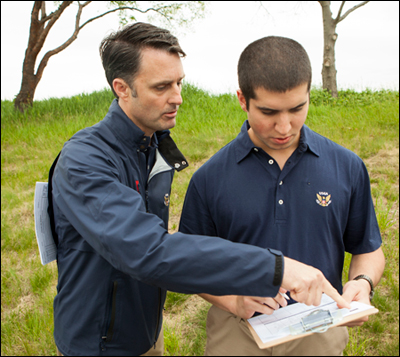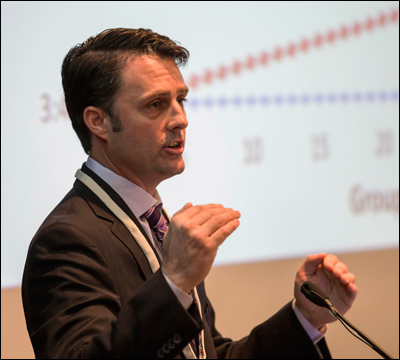A major part of the USGA’s mission is to make the game healthy and viable for generations to come, in part by improving pace of play. To that end, the USGA has been accumulating hard data to uncover the root of slow play on golf courses, and preparing to share their findings with golfers, facilities and leaders across the industry. This past summer, through the work of USGA Technical Director Matt Pringle and USGA Research Engineer Scott Mingay, the Association began to gather information using portable GPS devices from thousands of golfers, both recreational and competitive, to help identify pace-of-play issues.* Many aspects of this study will be discussed at the USGA’s Pace of Play Symposium, which will be held Nov. 12-13 at Golf House in Far Hills, N.J. Pringle recently discussed this work with USGA Senior Staff Writer David Shefter.

(*The WSGA assisted with this study by having on staff this summer a USGA P.J. Boatwright Intern. Jonathan Hrehov visited several Washington golf facilities, gathering data by giving the portable GPS devices to the region’s golfers for use during their round.)
Where are we in terms of the USGA’s pace-of-play study?
Pringle: We’re not at the results phase yet. We’re still in the analysis phase. But I would be shocked if we don’t come out with a number of actionable items. I think this shows the USGA’s commitment to solutions. It seems in golf all anyone wants to do is talk about [issues]. We’re trying to do something about it.
How many courses and people were involved in the study?
Pringle: We recorded data from 5,396 rounds this summer at 135 golf courses. They were private, public and municipal. Most of the rounds were recreational, but there were some state/regional competitions and some [USGA] qualifiers. We had an average of 40 golfers per event and the gender breakdown was 87 percent men and 13 percent women.
Did the USGA develop the program?
Pringle: We went from never having done anything like this to having eight interns stationed around the country and allowing them to plug these GPS units into their computer. The beauty of it is the raw data doesn’t change. It’s just a series of locations and times. But Scott [Mingay] is able to make tweaks to his program to allow us to measure other metrics. It’s a database and statistical analysis. It’s all singing and all dancing.

How big was the device?
Pringle: You stick it in your pocket. They’re like the size of a flash drive. And they just collect [data] from where you are every five seconds. It doesn’t transmit [data], it just collects. It’s time and location. That’s it. And we put a little sticker on them with an identification number. The golfer played with that and gave it back [to the intern].
Where did the eight interns come from?
Pringle: They were all science, engineering or math [college] students. We got them into various parts of the country, places like California, Washington, Colorado, Texas, Illinois, Virginia and Pennsylvania. They went to golf courses three to four times a week.
What other pieces of information did you collect from the golfers?
Pringle: On the first tee, the intern would ask the golfers a handful of questions. We would collect the age, the gender and the handicap if they had one. We asked them how far they drove the ball, how far they hit their 9-iron, walking versus carts, and if they used a caddie. We would collect what tee they hit from. We would collect if it was cart path only, 90 degrees or carts everywhere. All that is in the data sheet. And then they would ask the superintendent for the green about speed, rough height and difficulty of hole locations. Were they easy, medium or difficult? We’d get the weather conditions for that day.
Where did the information go?
Pringle: The player would take the [GPS unit] with them at the start of the round and then the intern would collect them as they finished. They would plug them into their USB drive and use Scott’s program to download the [data]. What Scott’s program would do is take a BING map, which is essentially Google Earth, and it would locate the first tee and first green, second tee and second green, etc. They were landmarks. His program would automatically compute the track. We don’t know where they hit from because it’s just recording time and location. But we can measure their speed. How long does it take to play 100 yards of a golf course? It would compute when [the golfer] started the first hole and when they finished the first hole. Most importantly, how far behind the first group was the second group and how far behind the second group was from the third group. That flow rate is the key.
Explain flow rate.
Pringle: It’s just like it is on the New Jersey Turnpike. When you use Google Maps on your iPhone to plan a route, it knows the traffic flow. It doesn’t know where every individual car is, it just knows things are flowing at 40 mph. That’s what we’re looking at. That’s why it isn’t important where exactly they hit their shot, but all that matters is how fast can golfers move around a golf course. If you as a golf course operator try to put more golfers on it than can flow through it, then traffic jams occur.

Have you seen any trends from the raw data?
Pringle: We’re in the midst of processing these 5,000 to 6,000 rounds, so we can get the flow rates and now we’re going to try and correlate them to all those other variables that we collected. And then we can say here’s what affected flow rate. So in 2015, we can actually deliver some actionable advice.
What are some of the culprits of slow play?
Pringle: First and foremost, we’re pointing to the fundamentals of tee-sheet management and very few golf courses have an active measurement and control system. I always say at the end of the day a golf course is like a factory that is producing rounds of golf. DuPont doesn’t try and run a chemical plant without measurement and control. We shouldn’t be running golf factories without measurement and control, either. And yet we are. Even if just basic measurements are taken, I think the golf course operator will realize a lot of improvement from that.
The USGA has also developed another piece of technology to help pace of play on the golf course. Can you discuss this innovative flagstick tool and what it can do to improve pace of play?
Pringle: In the hole is a magnet and at the bottom of the flagstick is a sensor. So it can detect when the flagstick comes in and out of the hole. And then that signal goes up into a little computer inside the flagstick. There’s a little GPS [unit] in there that tells us where the flagstick is and there’s a radio transmitter. That data can be sent back to a central computer, but the beauty of this is it can also talk to the next flagstick. The range doesn’t have to be very far. It just has to get to the next flagstick. Just like Google [Maps] is measuring the flow of traffic, this is telling us the flow of golfers. For those golf courses that don’t have a sophisticated GPS system or where you don’t take carts and walk, this is going to give them a cost-effective way to get the measurement they need to have control of the golf factory.
When will this device become available?
Pringle: We’re working with Spectrum Technologies, which is the same company that we licensed the TruFirm (measure firmness of greens) technology to. We’re partnering with them to develop this prototype system and they are hopefully going to have a working demo at the Pace of Play Symposium. And then we’re targeting February or March to have an 18-hole prototype system to put on a golf course and start fleshing out that this will actually work.
Do you envision every golf course using such a device?
Pringle: We’ll walk before we run. I think the logical thing to do would be to put them in the hands of some SRGAs (state and regional golf associations), but we’re considering several different business models. Right now, I’m more focused on getting a system that works.
Many courses have player-assistance personnel on golf courses, but there sometimes can be a frustration among golfers of these individuals not monitoring pace properly. How can this problem be remedied?
Pringle: That’s the whole measurement and control thing. Whether he does it with a cart-based GPS system or a flagstick tool or with a stopwatch, watching the gap between groups, he has to measure that gap and then control that gap. That’s the key. When you do that and balance it with a reasonable tee-time interval, then that’s 90 percent of pace problems.
Are golfers educated enough to understand flow?
Pringle: We know how critical it is that groups stay in position with each other. Do individual golfers know that yet? I don’t think so, and especially if nobody is telling them. If you go out there as a marshal and tell a group they are 15 minutes behind the group in front of them and we need you to be 10 minutes, and then if he comes back two holes later and you are 20 minutes behind, now that’s a problem. But if you are taking steps, OK, now the train is moving again. I’m hopeful that’s what the data is going to show us. This is how critical that is.
What is the ideal interval for tee times?
Eleven [minutes] is where we’re moving, but the ideal [spacing] is set by the golf course and the golfers. It’s all about matching the flow onto the golf course to the flow through the golf course. If a group can flow easily, then you can tee them off eight minutes apart. If the course is difficult or they aren’t matched well to the course, and it takes, on average, groups 12 minutes to fall behind, then if you have anything less than a 12-minute interval, then you’re going to cause a bottleneck. There’s no such thing as ideal. The idea is to balance the flow on to the flow within the golf course. That depends on the golf course and the golfers.
Have you worked with any of the professional tours on this issue?
Pringle: Their organizers have the same problems that golf course operators do trying to balance that flow rate. For example, we worked closely with the LPGA Tour this year. They have taken steps to improve that balance. Not going and pointing fingers at their players, but from a policy standpoint. They’ve lengthened their tee intervals, they’ve put in new policies to reinforce the notion of keeping pace with the group in front, and those two things have paid huge dividends for them. And they would pay dividends for any course. I think we can hold them up as an example of doing the right thing.

